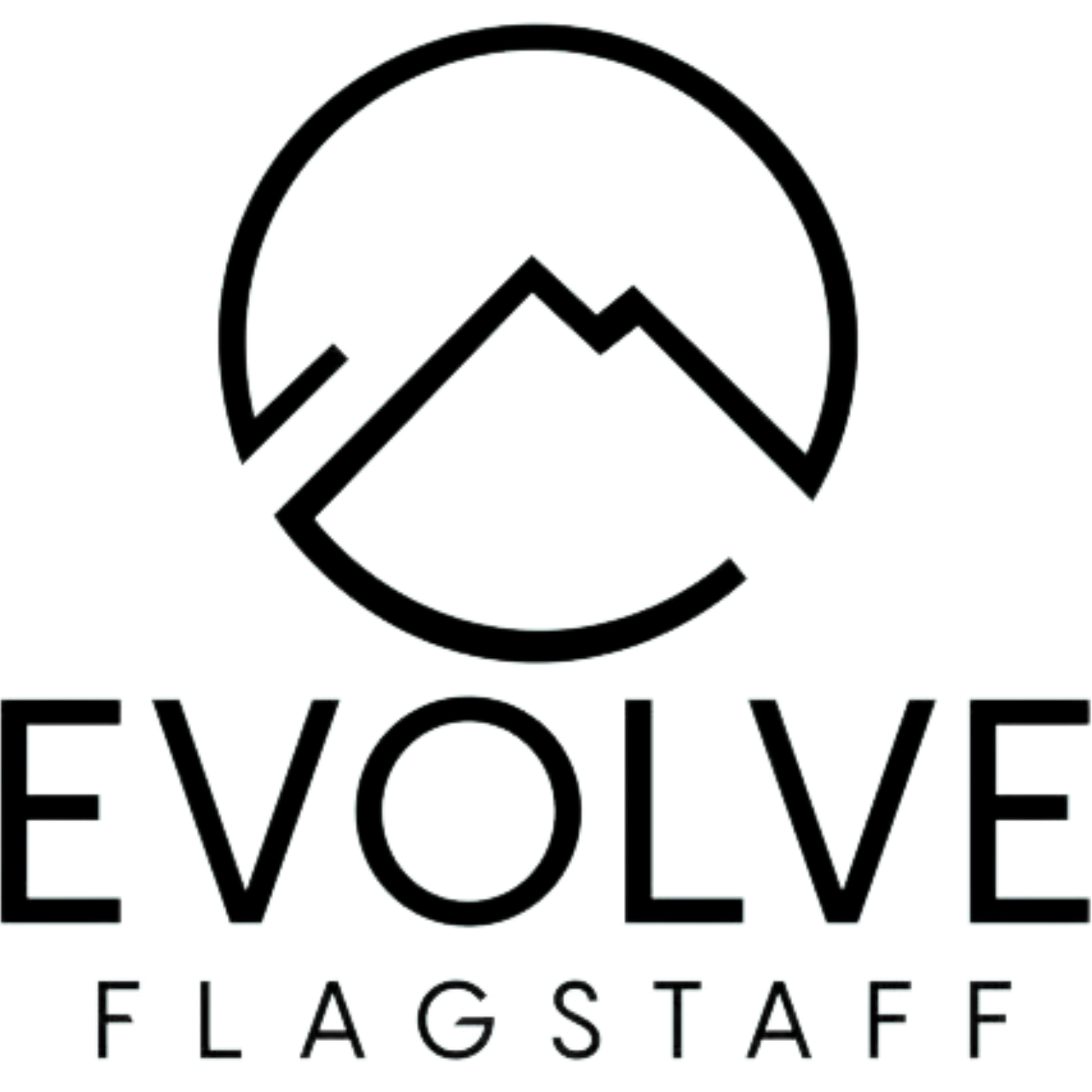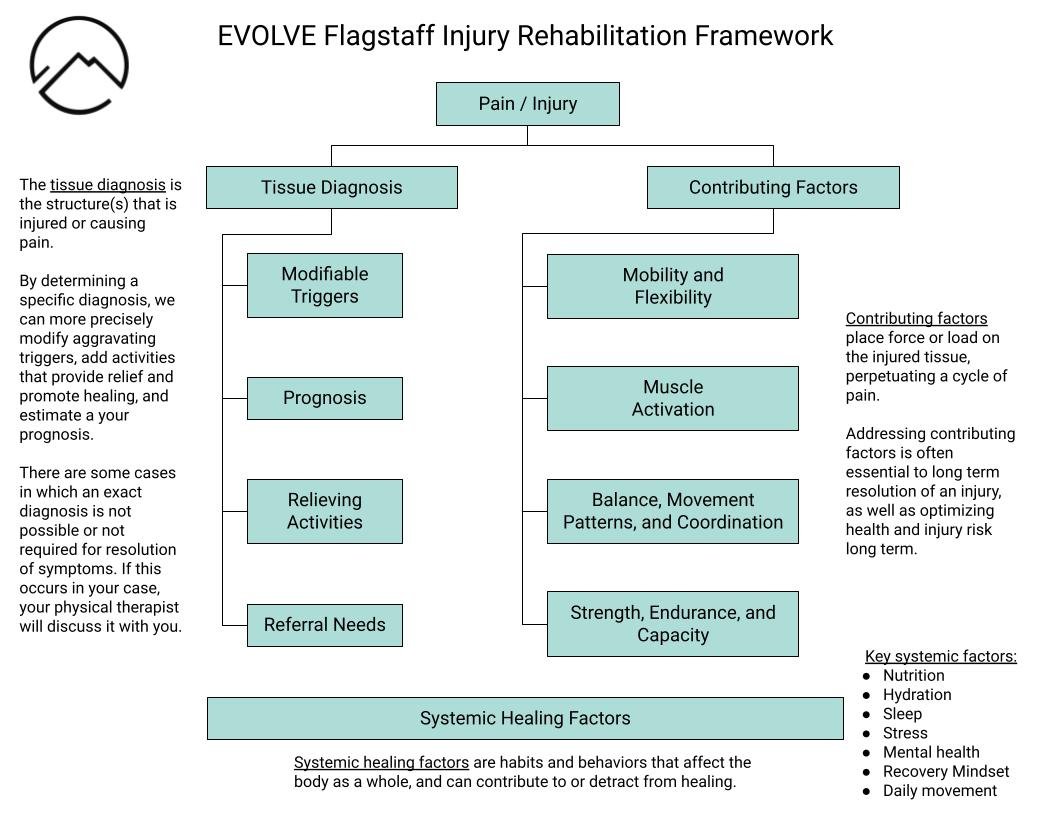Physical Therapy at EVOLVE Flagstaff
This article contains important information for all EVOLVE Flagstaff physical therapy patients. We find that we are most successful when our patients understand our treatment approach and philosophy, and are engaged in the process with us.
We know that some people are skeptical about whether or not physical therapy can work for them. Our current healthcare environment prioritizes imaging, medications, or surgeries. Popular media always seems to emphasize various stretching or massage techniques, or fad workout or diet program. Some patients have tried physical therapy elsewhere and have not seen success.
But, our approach to physical therapy at EVOLVE Flagstaff is different from other clinics. Our approach often helps create results for patients who have not seen progress elsewhere.
So what is different about physical therapy at EVOLVE Flagstaff?
EVOLVE’s Physical Therapy Approach
1-on-1 Time with a Doctor of Physical Therapy: Our time together is 100% focused on you. Our sessions are typically 60-75 minutes, in which we dive deep to understand you, your goals, and your issues, and to provide extensive education and treatment. Compare this to the 8-10 minutes that most physicians spend with their patients, and the rushed 20-30 minute PT sessions at many other clinics. We also do not pass you onto uncertified aids for exercises. Any activity, exercise, or treatment will be with your physical therapist. You will only be with one physical therapist to ensure consistency in your care.
We aim to provide a complete and useful diagnosis. To us, a complete diagnosis has two parts: 1) Your pain generator; and 2) Contributing factors to the pain generator. Let’s take a second to break this down.
Most healthcare providers, if they provide a diagnosis at all, stop at #1 - they simply tell you what’s hurting. This is important, as it can help direct the treatment approach. For example, we treat joint, tendon, muscle, ligament, nerve, and bone injuries differently.
But, many patients already know what hurts! So just telling them what their pain generators are is incomplete. We also need to know WHY. Why is the painful tissue not healing, or remaining painful and sensitized? What is putting abnormal loads or forces on the injured area? Why is the body not healing itself like we would expect? After all, if you bruise your elbow or cut your finger, the body does a good job sorting things out.
So, at EVOLVE, a complete diagnose has two essential parts: 1) What’s hurting, and 2) Why is it hurting? While these seems obvious, it is too often overlooked or muddled in our healthcare system, and leads to a disjointed or incomplete treatment approach.
We think comprehensively. Most healthcare providers work in a small silo, focused only on their speciality. In contrast, we have an integrated thought process that considers both your injury and your overall health. The body is a complex and interconnected system, and we achieve the best results when we consider multiple body systems in a cohesive way. For example, depending on your injury or pain, we may assess:
Joint range of motion in various positions or activities
Special testing of joint-specific structures such as ligaments, tendons, bursa, labrum, etc.
Muscle activation, strength, endurance, length, and trigger points.
Movement patterns and variability, and habitual postures (How you move matters!)
Your current activity and exercise levels (Movement is medicine, after all.)
Balance and movement control (How do you naturally create stability?)
Your kinetic chain (How does movement of one area affect the rest of your body?)
Nutrition and hydration (The body needs adequate nutrients or “raw materials” for healing.)
Breathing mechanics (We take 20,000 breaths a day; how we breath matters a lot.)
Stress and nervous system balance (Stress affect the body’s ability to heal.)
The lymphatic system (The body’s natural “detox” and clearance system.)
Sleep quality and quantity (The body’s most important recovery mechanism.)
We reflect and adjust: At the beginning of every visit, we pause to reassess how you are doing and how effective our plan of care is. We do not stay with a treatment approach if it is not working. Our aim is to achieve 80% improvement in symptoms 3-5 visits. While this is not always possible, it keeps us from being complacent and repeating a treatment process that is not working sufficiently.
We are focused: We do not prescribe an endless amount of exercises or template programs; every aspect of treatment has a purpose. Home plans are efficient and effective to maximize healing outside of the clinic.
We use evidence-based treatments: We often use manual therapy in the initial phases of treatment to reduce pain and promote tissue healing. However, we typically do not use ice, heat, ultrasound, or electrical stimulation as we find that these simply mask pain rather than address the root cause of the problem. We remain up to date with the latest peer-reviewed literature in orthopedic medicine and physical rehabilitation, and aim to use only the most effective treatments.
Care Coordination: We are able to coordinate our physical therapy treatment with nutrition counseling through our Registered Dietitian, Abby Chan, with our strength training programs, and with your life and the activities you love. Nothing happens in a vacuum.
Additional Tips for Success
There’s a few common traits among our patients who see the best results. These include a willingness to:
Work as part of a team. Even though EVOLVE’s physical therapists are great, we can’t “heal you” all on our own. We approach physical therapy with our patients as a team. The physical therapist’s job is to help develop the plan, provide treatments that you cannot perform on your own, and adjust the plan based on your progress. Your job is to perform your part of the plan as best as you can, and to come to your physical therapist with questions, problems, feedback, and concerns so they can make proper adjustments.
Work hard! The body can heal and adapt to almost anything, but the process often involves hard work! While our physical therapy approach often includes manual therapy initially, we have a large active component to every plan of care. The patients who see the best results understand that they can heal with proper time, attention, and effort. This typically includes some changes to your normal ways of moving, a few daily recovery activities, and perhaps a few strengthening workouts throughout the week.
Challenge their own thinking. If you’ve been struggling with pain or an injury, the true root causes may seem counterintuitive to you, or perhaps different from what you expected. Part of our physical therapists’ job is to provide extensive education about your problem, and we invite questions as a part of this process. But, there are many common myths and misconceptions perpetuated by social and popular media, and the healthcare system itself. Our most successful patients embrace trying new and potentially unexpected approaches to their problem.
Access to a gym, or some basic equipment at home. We will tailor our treatment plan and home program to the equipment and resources that you have access to. However, we are typically able to achieve better long term success with some basic home equipment. Equipment that we commonly recommend includes: a lacrosse or massage ball, a foam roller, a heavy and light mini band, a heavy and light power band (or dumbbells/kettlebells up to at least 35 pounds), and a door anchor for the power bands. You can purchase all of this equipment for less than $100 on Amazon (view a product list here), and we sell most of it at EVOLVE Flagstaff as well.
What to expect at your first visit
At the first visit, we will try to do the following together:
Review your medical and pain/injury history.
Establish short and long term goals: what do you want to accomplish in the next hour, the next month, and the next 3-6 months?
Perform a complete assessment to determine a comprehensive diagnosis that includes both the sources of your pain/injury (“pain generators”), and underlying root causes of the pain generator (your “contributing factors”).
Provide extensive education about your pain generators and contributing factors, and discuss any uncertainties in your assessment.
Create a plan to address both your pain generator(s) and contributing factors with manual therapy, movement retraining, and exercise.
Determine your prognosis and our expectations of your healing timelines and return to full activity.
Provide treatment to your pain generator (our goal is to reduce your pain on the first day if possible - we do not want to wait).
Create an initial home to begin addressing your most important factors.
There is a lot of cover, but we aim to make the most of our time together so you achieve your goals faster.
Essential Questions to Guide Your Care
We are a team. As such, we need to work together to achieve your goals. Your feedback and input is essential. These are some common questions that we ask in both initial evaluations and follow ups provide you with the best possible care, and adjust your plan when necessary:
With respect to your pain/injury, where would you like to be in 3-6 months?
What are your goals for this session? What would you like to get out of the next hour?
On follow up visits: From 0% to 100%, how much better do you think you are compared to your first visit? What would things look like at 80%, 90%, or 100%?
What do you think is working, and what is not working?
What questions or concerns do you have?
Additional Recommended Reading:
If you have any questions about EVOLVE physical therapy, please do not hesitate to contact us or set up a free strategy phone call!

